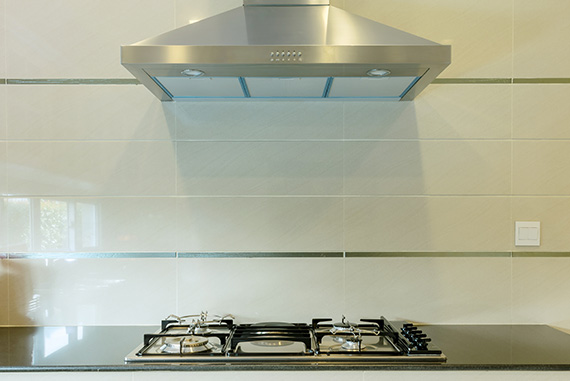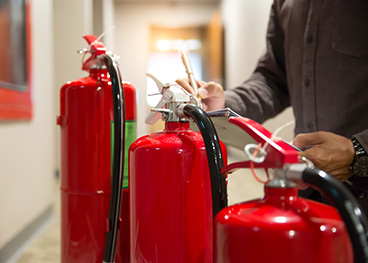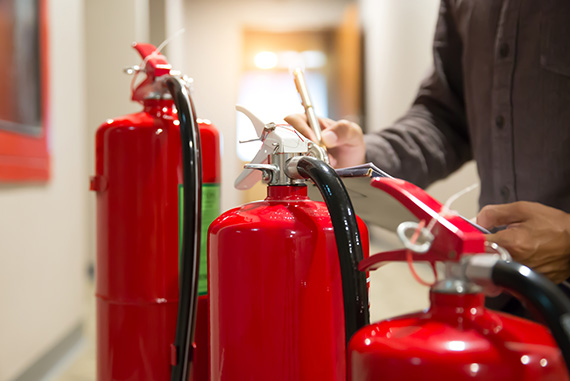By Michael H. Acquilano, President, FireServ
There are many types of fire and life safety equipment that are required in a typical commercial restaurant. These include portable fire extinguishers, sprinkler and fire alarm systems. This equipment has proven to save lives and reduce property damage.
However, due to the nature of cooking in the restaurant, the most important protection is required in or around the cooking appliances. According to certain national statistics, in a typical year, 5,100 fires are started by cooking appliances. Given that only 20% of fires are officially reported, the number could be higher. The kitchen range hood fire protection system provides an effective automatic, as well as manual means of dealing with a cooking area fire situation.

It is important to note that a common mistake is to refer to the kitchen fire suppression system as an “Ansul” system. This is similar to calling tissue “Kleenex.” Like Kleenex, Ansul is just one brand of fire suppression system. Other manufacturers include Amerex, Kidde, Range Guard and Pyro-Chem.
In the event of a fire over the cooking appliances or in the ductwork, the first line of defense is the fire suppression system. Engaging the manual pull station can activate the fire system or more commonly, the system will automatically discharge when the fire reaches a certain temperature. The discharge of the system will also shut off the gas and turn off any electrical appliances. The kitchen should also have a K-Class type portable fire extinguisher, which is designed specifically for use over cooking surfaces. Activating the system first in this situation is contrary to what is taught about portable fire extinguishers being the first option in the event of fire. You should never try to fight a cooking equipment fire with a portable fire extinguisher without first discharging the system.
In basic terms, the automatic system works as follows: the increase in the intensity of the fire sets off fusible links that are designed to snap in half at a certain temperature (typically 360 or 500 degrees). This separation of the link(s) triggers the actuation mechanism, which releases the contents of the system cylinder through piping and nozzles. The wet chemical agent discharges into the plenum and duct area and onto the cooking appliances, effectively knocking down the fire and coating the surface. This coating facilitates saponification, which is a cooling down of the cooking median that prevents reignition.
Once the system has been activated and done its job, restaurant personnel must call their authorized fire suppression contractor. The system cylinder must be recharged and the system must be put back into service. The restaurant must not begin cooking again without the system in proper working order, as it cannot operate without proper protection.
Before a fire situation happens, it is very important that the restaurant has already put into place a “proactive” approach to fire safety. This approach, as it relates specifically to kitchen range hood fire suppression systems, should start upon either moving into an existing space or building a new restaurant. Either the general contractor or your maintenance/facilities department should provide plans for the kitchen to a licensed kitchen range hood fire suppression contractor. The contractor will then propose the size and type of system needed and what is required by the local AHJ in terms of drawings, permits and witnessing performance tests prior to opening.
Typically, the AHJ will follow the guidelines set forth in the National Fire Protection Association (NFPA) Standard for Wet Chemical Fire Extinguishing Systems, NFPA-17A, UL-300 and manufacturer’s specifications. The layout of a particular appliance line and duct system will determine the amount of protection required.
With the advent of UL (Underwriter’s Laboratories)-300 in 1994, there is basically one type of extinguishing agent found in fire suppression systems: alkaline-based wet chemical. The UL-300 standard was created to meet the new types of appliances and the higher temperature cooking oils. It made the old dry type systems obsolete. Most AHJ’s allowed the dry systems to stay in place until either the cooking appliance line or duct system was altered or the system came due for hydrotesting.
UL recognized the need for a safer and more reliable fire-extinguishing agent based on the desire for healthier vegetable cooking oil and the improvement on the power generated by the standard types of appliances. With this in mind, your kitchen fire suppression contractor should be following the specifications of UL-300 not only for new installations, but also when servicing existing systems.
As part of the “proactive” fire safety approach, it is important that the restaurant has put a training program in place for managers and other associates on how to properly use the fire suppression system and fire extinguishers. This information should be passed on to each new employee. Your fire suppression contractor will be able to assist you in providing the proper learning materials for such a program.
In addition, a maintenance program must be put in place. This requires participation by both designated store employees and your fire suppression contractor. Per NFPA-17A, store personnel should perform a monthly quick check of the fire system. This “inspection” includes making sure system cylinders are in their proper locations, pull stations are unobstructed, nozzle blow-off caps are in place and the cooking appliance line has not been altered. This quick check should also include seeing that the safety seal on the cylinder and pull station is not broken, the pressure gauge reading is in the operable range and the contractor’s service tag is in place. The restaurant should also have a hood-cleaning contractor performing quarterly (or more frequently, if needed due to heavy grease build-up) cleaning of the hood and duct system per the requirements of NFPA-96.
Per NFPA-17A and manufacturer’s requirements, on a semiannual basis, the fire suppression contractor must perform an on-site “maintenance” of each system. To do a proper service, no cooking can be done during this time (heat will prevent technician from being able to have access to appliance line and duct system). This maintenance includes all aspects of the monthly inspection described earlier, plus a thorough examination of all mechanical parts and checking the releasing devices, piping, hose assemblies and nozzles. A trip test should be performed to determine proper mechanical operation of the system, including fuel shutdown and any auxiliary functions. Most importantly the fusible links must be checked for grease build-up and changed per manufacturer’s specifications, which is typically semiannually. It also includes filling out a system report and noting the need for repairs and/or testing. The month and year of these services is noted on a tag affixed to the system cylinder and pull station.
The fire protection industry, in conjunction with local AHJ’s is continually working together to educate the public on the importance of kitchen range hood fire suppression systems. The effect of extinguishing a fire at its early stages can prevent injury and death, as well as minimize property damage.
In conclusion, safety and the prevention of loss of life shall be the two most important issues. Therefore, it must be stressed that kitchen range hood fire suppression systems and Class K fire extinguishers are intended to put out a fire in its initial stages. No store employee should try to put out a fire that is blazing. Fires spread quickly and the smoke and gases emitted from the fire can be toxic. If there is any doubt about the employee’s ability to put out the fire, he or she should back out of the store exit immediately, attempting to close the door behind them to limit spreading the fire, then wait for the local Fire Department to arrive.
Author Bio
Michael H. Acquilano is the President of FireServ, which provides nationwide fire protection compliance for retailers. He has been in the fire protection industry since 1989. FireServ is based in Brooklyn, New York.






